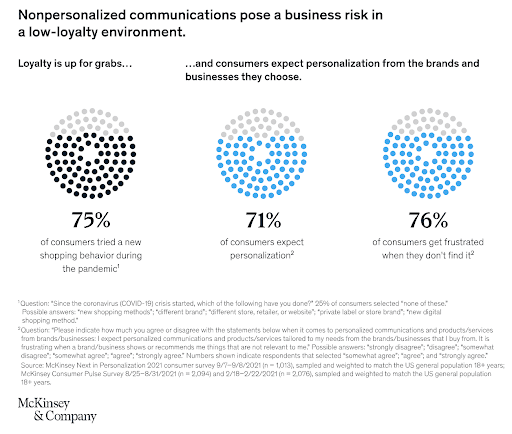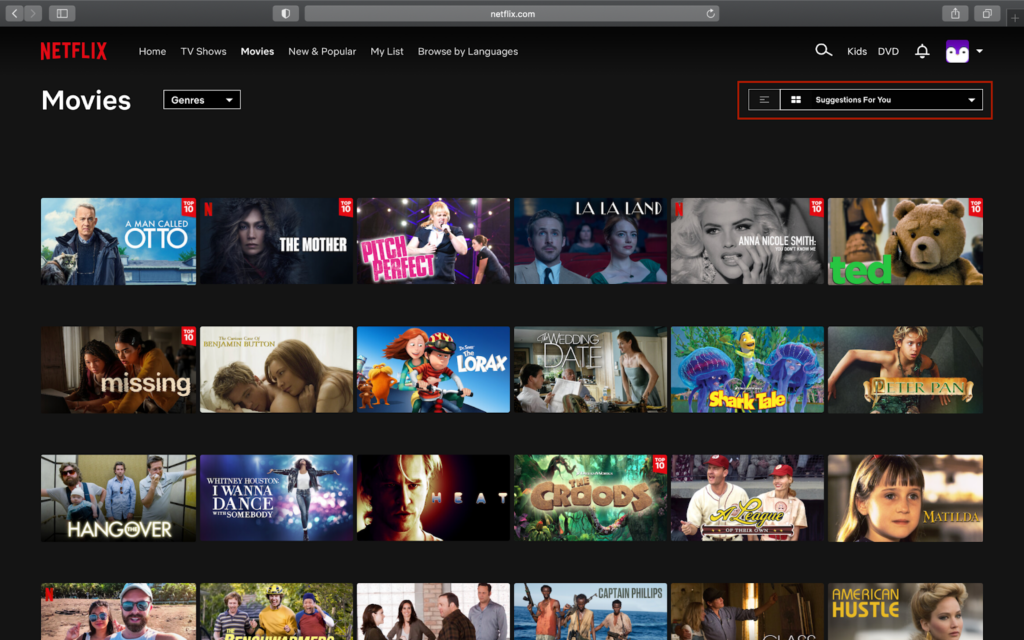In the digital world, as we know it, consumers are constantly bombarded with advertisements and marketing messages. That means businesses must stand out and deliver personalized experiences to target the right audience. Personalization refers to tailoring marketing content and advertising messages to individual preferences and needs.
The good news….
Companies can now create highly targeted campaigns that resonate with customers by leveraging data and advanced technologies like big data and artificial intelligence (AI).
The bad news….
Companies (including your competitors) will jump on the AI bandwagon, meaning everyone will sound the same as they are likely using similar concepts and sources, for example, ChatGPT.
We’re not saying you should never use AI or technology to help further advance your advertising efforts. But the main question you want to answer is…
If everyone’s doing the same thing, how will I differentiate from the crowd and stand out amongst my competitors?
In this post, we will explore the significance of personalization in digital advertising, understand the role that data personalization plays, discuss strategies for utilizing data effectively, highlight a few successful examples, address some challenges and potential pitfalls, and look into the future trends of ethical considerations.
Understanding the Role of Data in Personalization
Data plays a pivotal role in personalization. With the advent of big data, businesses can access vast amounts of information about consumers, including their demographics, preferences, purchase history, and online behavior. This data can be harnessed to gain insights into customer preferences and create personalized advertising experiences. AI and machine learning have further contributed to analyzing this data, allowing businesses to understand patterns and trends in their consumer behavior and deliver targeted ads to the right audience.
Benefits of Leveraging Data
There are several benefits of leveraging data for personalization. One of them is that it enhances customer engagement. When consumers receive tailored advertisements that you align with their wants, they are likelier to pay attention and engage with the ad. This leads to increased brand awareness and is more likely to convert.
Speaking of conversion, personalization increases conversion rates. According to Econsultancy, a report found that “93% of companies experienced a rise in conversion rates after personalizing”.
Your business can guide consumers toward purchasing or taking action by delivering personalized messages and recommendations. It has been proven that customized ads have a higher conversion rate compared to generic placements.
Personalization also improves customer satisfaction and loyalty. When you understand your customer’s preferences and provide relevant recommendations, it creates a positive brand perception. As a result, customers will feel valued and more likely to build a long-term relationship with your brand, leading to increased loyalty and repeat purchases or service use.


Strategies for Utilizing Data in Personalization
To effectively utilize data for personalization, you should focus on collecting and analyzing customer data from various touchpoints. This would include data from website interactions, social media engagement, purchase history, and customer surveys. According to Convince & Convert, “Today, the type of data collected for marketing use goes far beyond the traditional name, company, and title. Over half (55%) of marketing professionals say that website activity is the most important type of marketing data utilized for personalization efforts.” By integrating and analyzing this data, your business can comprehensively understand your customers’ behaviors and preferences.
Data collection should be done ethically and with customers’ consent. Transparency regarding data usage and reassurance of data privacy is essential to maintain customer trust. Your company should implement robust security measures to protect customers’ data from unauthorized access or breaches.
Targeting and segmentation are also vital components. By utilizing demographic, psychographic, and behavioral data, you can divide your target audience into segments and deliver personalized messages to each group. In addition, developing buyer personas can further enhance personalization efforts by creating detailed profiles of said customers and tailoring your content to their needs and preferences.
Customizing content creation is another crucial aspect. This would include creating relevant ad copy, landing pages, video production, and other content that would resonate with your target audience. Dynamic website content and product recommendations based on user behavior can also enhance the personalization experience. Placing videos and tailored social media advertising effectively deliver customized messages to your consumers.
How we Personalize Ads For Our Clients
Location
When it comes to personalizing ads for our clients, one of the ways we target audiences is by specific locations that can significantly enhance the effectiveness of their campaigns. For example, suppose one of our clients is a contracting business based in Denver. In that case, it’s probably a good idea to focus on reaching people in the Denver area who are actively seeking contracting services. By customizing content based on location, we can create a more relevant and engaging experience for their target audience.
Including images of local landmarks in the content also helps create a sense of familiarity and connection with the audience. When people think of Denver, they think of mountains. So, displaying images of downtown or the mountains in the background can instantly resonate with those living in or around this city.

Keywords should also be optimized for searches that are local by emphasizing the location in the search terms. For instance, we would use phrases for our hypothetical client such as “contractors in Denver,” “Denver home renovation service,” or even “Denver home remodeling.” These phrases can attract the type of attention from people in the Denver area who are specifically looking for these services.
Now the ad copy itself should be based on the city as well. We would use copy like “find a reliable contractor in Denver” or “Quality home renovation services in the heart of Denver” to grab the attention of the locals. This approach shows that our client understands their needs and desires to help the people in the area with all their contracting needs.
Demographics
Understanding the demographics of our client’s target audience is another aspect of personalization we consider. For our clients like Terra Education and iXperience, targeting college students is the best strategic approach we can offer them. We tailor their content to college kids’ interests and needs to reach their specific demographics effectively.
Images we use as material reflects on students and the college experience itself. These pictures could be students studying, participating in campus activities, or collaborating on projects as an approach we use to reach this demographic. These visual ads can create relatable and aspirational connections between our clients and students, making them feel represented and engaged with a new experience for them,
When factoring in keywords, we focus on college students and their interests. Therefore, we like to use phrases like “internships for college freshmen,” “internships abroad,” or “enhance your college education” that can bring in the right crowd of college students who are looking for new and unique opportunities to gain an advantage in their academic as well as professional journeys.
Our ad copies for Terra or iXperience are solely based on their audiences being college students. Highling the benefits of each of their programs in terms of enhancing college education, gaining real-world experience, and preparing for future careers is pivotal for our clients, which we assure to do for them.
Interests
We also like to personalize our ads for our clients based on people’s interests since it can significantly enhance the effectiveness of their campaigns. Our clients, Discover Corp, have different sectors, with international festivals in particular, that we enjoy working on. We want to help spread the word about these festivals that cater to people with this passion.
Images we would use showcase vibrant and diverse international festivals like the Day of the Dead, Carnival, and more popular events. Showing people around the world enjoying these festivals create an emotional connection with the audience and sparks their interest to take a chance and travel to these events.
Using phrases for Discover Corps like “festivals in Peru” or “experience the best international festivals” is a game changer to bring in tourists actively looking for upcoming events. Other options that could be included would be “Day of the Dead festivals in Mexico” or “Carnival in Brazil,” are some other ones that can pique travelers’ interests.

Highlighting the cultural immersion, performances, and memories that consumers could gain from these festivals can be an excellent angle for Discover Corp’s ad copy. It focuses on the unique and enriching experiences of attending international festivals and truly engages its target audience on what “could’ve been them.”
Examples of Successful Personalization by Companies
Hundreds of companies have excelled in delivering personalized experiences to their customers in the past few years.
Amazon, for instance, is known for its personalized product recommendations. By analyzing purchase history, browsing behavior, and customer reviews, Amazon suggests products likely to appeal to individual customers, increasing the likelihood of a purchase. Amazon also tailors its email campaigns and retargeting ads based on previous customer interactions and interests.

Netflix, the popular streaming service, is another example of successful personalization. Netflix analyzes users’ viewing history, ratings, and preferences to provide personalized movie and TV show recommendations. The platform also customizes the user interface, showcasing content based on individual interests and creating a seamless and customized streaming experience.

Spotify, the leading music streaming platform, utilizes personalization to curate playlists and recommend music based on users’ listening habits. With its “Discover Weekly” or “Only You” playlists, Spotify offers a tailored selection of songs every week, introducing its users to new artists and genres that align with their current music preferences or obsessions.



At the end of every year, they also have a “Spotify Wrapped” segment, showing who you listened to the most in the past year, with similar suggestions from other artists. This personalized approach enhances the user experience and engages customers with their platform.

Overcoming Challenges and Potential Pitfalls
While personalization offers substantial benefits, you need to be mindful of specific challenges and potential pitfalls that may come along the way. Ensuring data accuracy and quality is crucial. Data integrity plays a vital part in making accurate predictions and delivering relevant, personalized experiences. Businesses should have robust data management processes in place to validate and cleanse the data regularly.
Maintaining customer trust and privacy is a top priority. Your business must handle customer data responsibly and transparently. Implementing strong security measures, obtaining proper consent, and adhering to data protection regulations are essential to maintain customer trust in the era of data-driven personalization.
Finding the right balance between personalization and intrusiveness is also essential. While personalization can enhance the customer experience, avoiding crossing the line and making customers feel uncomfortable or overwhelmed with your ads is noteworthy. Businesses should carefully analyze customer preferences and behavior to ensure that personalized messages and recommendations are relevant and valuable.
Future Trends in Personalization
The future of personalization lies in hyper-personalization and real-time customization. With advancements in AI and machine learning, businesses will be able to deliver even more tailored and real-time experiences. This could include personalized offers, dynamic pricing based on individual preferences, and real-time recommendations.
Voice-activated personal assistants and chatbots are also expected to be a game-changer in personalization. These AI-powered tools can understand and respond to user queries, providing personalized recommendations and assistance based on individual preferences and behaviors. Remember, even though AI-powered tools may seem more time efficient from a customer-service-based stance, you may still want to keep a name to a face so your customers are now communicating with a real-life person.
Ethical Considerations in Data Usage and Personalization
As more and more agencies and businesses embrace personalization strategies, they must also address ethical considerations. Transparency and consent are paramount to collecting and using customer data. Your business should communicate how data will be used and let your customers know they have control over their data. Additionally, data should be anonymized and aggregated whenever possible to protect individuals’ privacy.
Personalization has become a powerful tool in advertising and marketing, enabling businesses to deliver new and exciting experiences that resonate with customers. The availability of big data and advancements in AI has revolutionized how companies utilize data to create personalized campaigns; leveraging data effectively can enhance customer engagement, increase conversion rates, and foster customer satisfaction and loyalty. However, you need to factor in challenges that may arise to ensure ethical data usage to maintain customer trust. Looking ahead, hyper-personalization and real-time customization will continue to shape the future of personalized advertising. At the same time, brands must navigate ethical considerations to find the sweet spot between privacy and personalization. Embracing personalization strategies can significantly enhance your customer satisfaction and drive business growth in the competitive landscape of this digital era.

